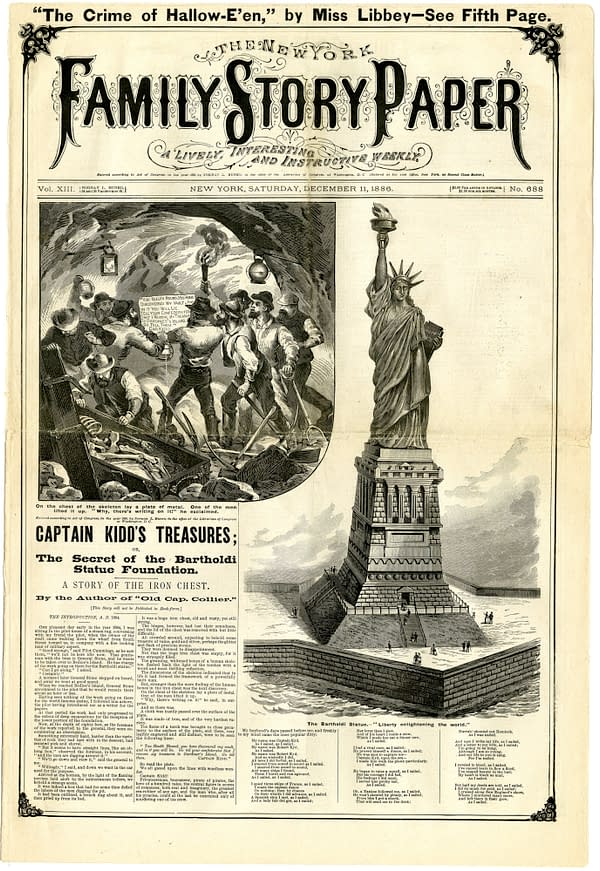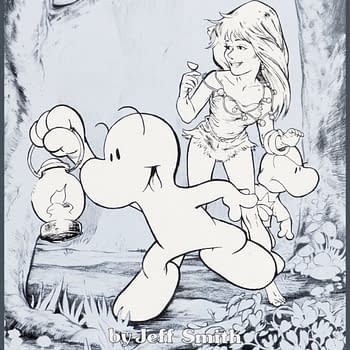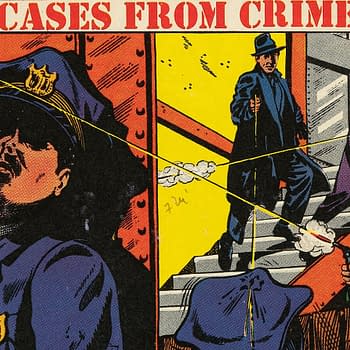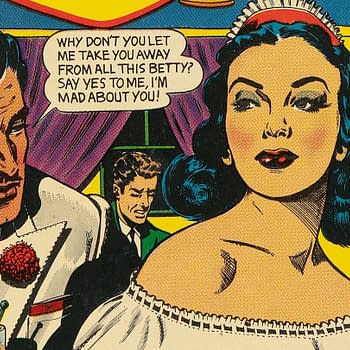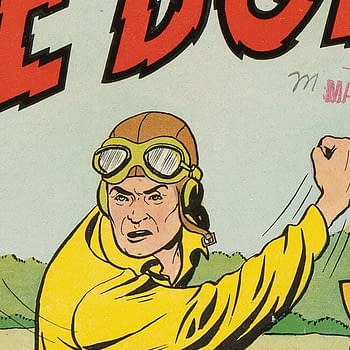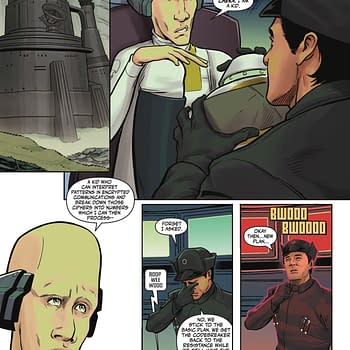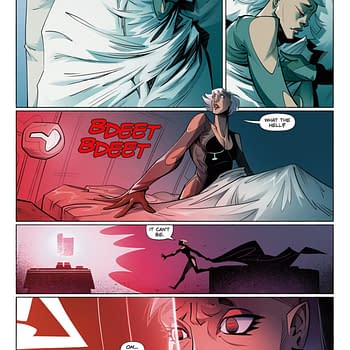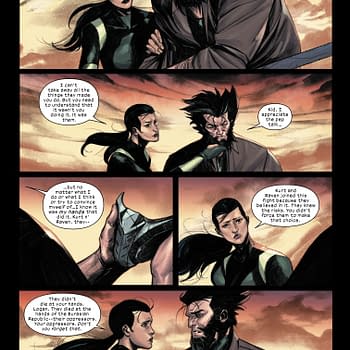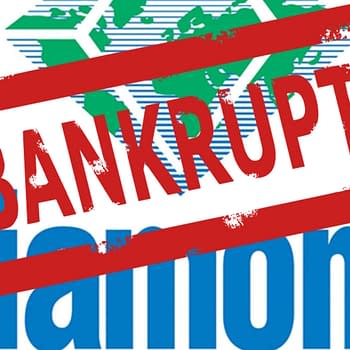Posted in: Comics, Vintage Paper | Tagged: norman l. munro, story papers, the issue
THE ISSUE: Family Story Paper, Norman Munro and Trade Waiting in 1886
Family Story Paper #688 includes a blurb that indicates that the Trade Waiting concept was already a thing in 1886.
Family Story Paper #688, December 11, 1886, cover-features part one of a serialized story titled Captain Kidd's Treasures; or the Secret of the Bartholdi Statue Foundation, a tale which combines then-very-recent American and New York history with much older history of the area for a mystery story with some horror overtones. Interestingly, the issue also warns potential buyers that this serialized story will not be collected. The Issue is a column about vintage comics and other vintage periodicals from throughout world history. The idea behind The Issue is simple: for each post, I'll choose something from my collection and talk about what's going on in it, and discuss the publishers and creators behind it. And essentially, I'm just going to end up stepping through comics history one issue at a time. There is only one rule in The Issue: No recent stuff. Everything will be from before 1940, and most of it will be from before 1920.
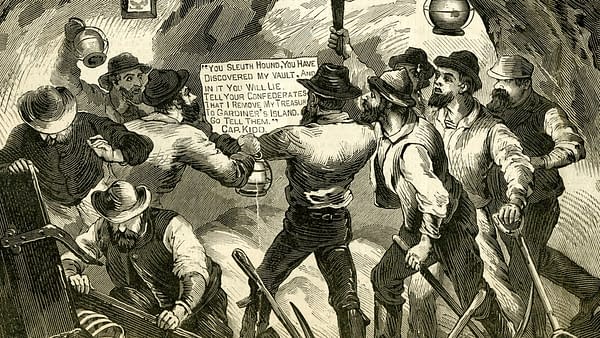
Story Papers and Trade Waiting
Family Story Paper was a general-interest weekly fiction paper that lasted for nearly 2,500 issues from 1873-1921. It is widely considered to be one of the best-selling story papers of its era, and was part of the basis for publisher Norman L. Munro's considerable fortune. We've discussed Munro here a few times, as he (and a handful of his publishing contemporaries) is a vastly underappreciated figure in the direction of popular, mass-market newsstand fiction in America. A "story paper" is simply an illustrated weekly periodical that features fiction, in what we think of as a newspaper format. The serials featured in story papers were often collected into complete stories called libraries, in a stapled-together quarto format (roughly the size of a golden age comic book or a modern magazine). The story paper format was thus the general equivalent of the comic book from the perspective of the newsstand patrons of that era, while libraries were equivalent to the modern collected edition — though almost always much slimmer in page count. Some story papers of this era ran letter columns full of fan questions that might be answered by the editors. There was also already the beginnings of an organized fandom by this period, and in 1889, Munro held a national convention for fans of his story paper Golden Hours.
Notably, Family Story Paper #688 prominently includes the blurb "This Story will not be Published in Book-form" at the beginning of the tale, which is a strong indication that "waiting for the trade", the phenomenon of waiting to purchase the collected edition rather than buying the serialization was already in effect and that some publishers were concerned about it. It's also noteworthy that Munro was less reliant on the library edition format than most of his contemporaries, though he did publish some.
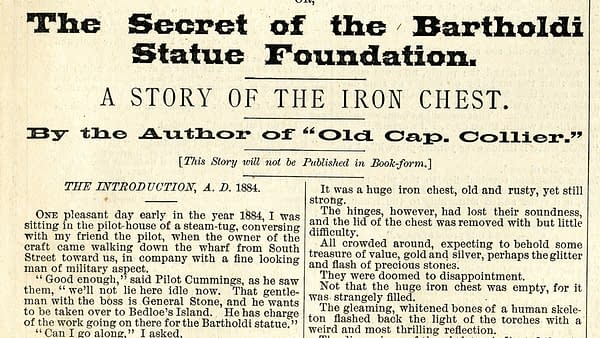
That said, Family Story Paper enjoyed a nearly 50-year, 2,500-issue run and helped make publisher Norman L. Munro a very wealthy man. One of his indulgences was an utter obsession with building the world's fastest steam yacht, for which he hired brilliant MIT-educated engineer Nathanael Herreshoff, whose earlier claim to fame was in overseeing the installation and operation of the monstrous 40 ft tall Corliss Engine which powered the 1876 Centennial Expo and captured the nation's technological imagination in the process. Herreshoff would go on to become a legend in shipbuilding history, and every America's Cup winner 1893-1920 was a Herreshoff design. In some circles, Munro is far more famous for his role in helping kickstart this than he is for publishing story papers.
The Fictional Secrets Beneath the Statue of Liberty
While this issue was published just a few weeks after the Statue of Liberty's October 28, 1886, public dedication, the story introduction sets the scene two years prior in 1884. Notably, one of the characters named here is "General Stone", a clear reference to the real-life Charles Pomeroy Stone, a Mexican War and Civil War veteran who later worked as a civil engineer, and became the Chief Engineer of the Statue of Liberty project in 1884. As our story opens, a metal chest is found while constructing the foundation of the statue on Bedloe Island, and along with the chest, a message:
"You Sleuth Hound, you have discovered my vault, and in it you will lie. Go tell your confederates that I remove my treasures to Gardiner's Island. Go tell them."
Signed Captain Kidd.
Gardiner's Island is a small island off the east end of Long Island, and was the site of the first English settlement in New York. Captain Kidd had buried some treasure on the island with the cooperation of the Gardiner family in 1699. Norman L. Munro died in 1894. Murry Guggenheim bought the grounds of his NJ estate after he died, and it is now part of the Monmouth University campus. Munro's wife Henrietta took over the operation of his publishing business after his death.
